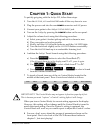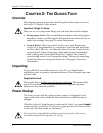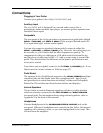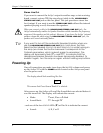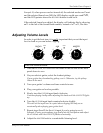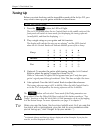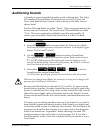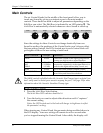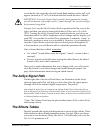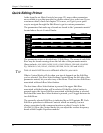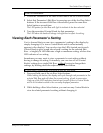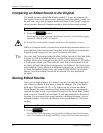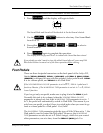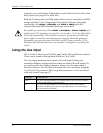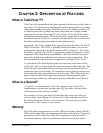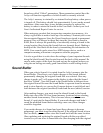
The Guided Tour: Chapter 2
AxSys 212 User Manual 13
revert back to the currently selected Sound Bank number; notice an E will
appear (instead of a P or U) to indicate that the Sound has been ÒeditedÓ.
IMPORTANT: Since each Control knob is used for lots of parameters, turning
one will not have an instant affect until it Òpasses throughÓ the current setting of
the parameter being edited.
Example: LetÕs say the
DRIVE Control Knob is positioned all the way to the
right, and then you select a Sound which has its Drive set to 12 oÕclock
(50%). Turning the
DRIVE Control Knob counterclockwise wonÕt have an
immediate affect (its LEDÕs brightness will not change and the display will
read 50). You wouldnÕt want the Drive parameter to suddenly ÒjumpÓ to
the knobÕs position as soon as you touched it. However, if you continue to
turn the Control Knob counterclockwise so that it passes through the 12
oÕclock position, you will then be able to adjust the parameter directly.
Once a Sound has been edited,
remember:
¥ An ÒeditedÓ Sound differs from its original, ÒstoredÓ version (what a
concept!).
¥ If a new Sound is selected before storing the edited Sound, the edited
Sound will be lost (what a bummer!).
Once youÕve made adjustments that youÕre happy with, you will want to
store the Sound to save these changes and make them permanent. See
page 16 for information about storing an edited Sound.
The AxSys Signal Path
On the right side of the front Panel thereÕs an illustration of the AxSysÕ
internal signal path. This will help you learn the order the signal passes
through each of the internal digital components. The path is:
Guitar Input ➠ Noise Gate ➠ Compressor ➠ Volume Pedal* (Pre) ➠ Distortion Box ➠
Wah ➠ Preamp EQ ➠ Preamp ➠ Volume Pedal* (Post) ➠ Auto Volume ➠ Graphic EQ ➠
Bass/Middle/Treble ➠ Stereo Tremolo ➠ Stereo Delay ➠ Stereo Chorus ➠ Stereo Reverb
➠ Cabinet Simulator ➠ Speakers
* Note: The Volume Pedal may be placed either before (Pre) or after (Post)
the Preamp section.
The Effects Tables
Directly beneath the signal path diagram are a series of effect tables. These
tables indicate what various parameters mean. Example: When you know
you want to use the Stereo Delay, the
DELAY TYPE table tells you to set the
DELAY TYPE parameter to 2.



